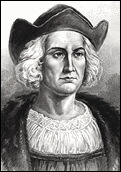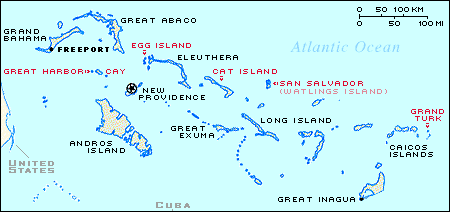Just When Did Columbus "Discover" America—and Where Was He?

Just Where Was Columbus?
 Christopher Columbus The VoyagesFirst Voyage, Second Voyage, Third Expedition, Fourth Expedition, Related Links |
Christopher Columbus, of course, thought he had arrived in the "Indies," an old name for Asia (although the phrase "the East Indies" is still often used in historical reference to the islands of southeast Asia). Using Marco Polo's Travels among other sources, Columbus calculated that his voyage would lead him to Cathay (China), Cipango (Japan), the Spice Islands (the Mollucas), and India.
If Columbus Didn't Discover America, then Who Did?
Many people have pointed out that Columbus couldn't have "discovered" America since there were already hundreds of nations living there. That's true. Columbus simply made the existence of North America known to Europeans. But, even then, he wasn't the first foreign person to arrive in the New World. At some unknown point in the past, people from Polynesia probably made contact with the native peoples of South America; the sweet potato seems to have migrated from Asia to South America, probably as a result of being carried by Polynesian sailors.
The first Europeans to arrive were the Vikings from Greenland. Likely led by the explorer Leif Erikson, the norse sailors founded the first colony in what is now Newfoundland, in Canada. And, if by America we mean the United States, Columbus never set foot in any part of the modern US.
A Slow Boat to China
The Italian explorer Columbus, from Genoa, left his home to travel across Europe to find patrons. He was unable to raise funds in Italy, so he appealed to Portugal. Contrary to a popular folk myth, he was not trying to prove the Earth was round; most educated people knew the shape of the Earth by then. In fact, when the Portuguese refused to fund his voyage, they claimed that he was underestimating how long it would take to sail across the globe to Asia. So, he left Lisbon and appealed to Queen Isabella of Castile and her husband King Ferdinand, the monarchs of Spain. In the mid-15th century, Spain had colonized the Canary Islands off the coast of Africa, and they were looking to continue their colonial expansion.
The crown's support most famously included three caravels, the Niña, the Pinta, and the Santa Maria.
After landing on a small island on Oct. 12, 1492, in what he believed were the Indies, Columbus sailed along the coast of Cuba, certain that he had finally reached the continent of Cathay. This is why Columbus Day in the US is celebrated on the second monday of October (although the holiday is increasingly controversial).
He searched in vain for the magnificent cities Marco Polo had described, hoping to deliver a letter from the Spanish monarchs to "the great Khan," the Chinese emperor. "Afterwards," Columbus wrote on Oct. 21, "I shall set sail for another very large island which I believe to be Cipango, according to the indications I receive from the Indians on board." Columbus's Japan proved to be the island of Hispaniola.
Refusing to Ask for Directions
Three voyages later, Columbus still resolutely maintained that he had reached Asia despite growing contrary evidence. Amerigo Vespucci's 1501 voyage along the coast of South America convinced most explorers and their patrons that a huge unexplored continent existed across the Atlantic—what Vespucci called Mundus Novus, the New World. Columbus, however, died in 1506 still insisting that he had found a new route to Asia.
The first important Caribbean colony was founded on La Hispaniola, the island that today houses the Dominican Republic and Haiti. But, the location of Columbus's landfall in the New World is still contested.
 Columbus's arrival point in the New World is still contested. |
Where in the New World is San Salvador?
But confusion over where Columbus landed in the New World has not been restricted to the explorer himself. For centuries scholars have hotly debated where Columbus first set foot in the Western Hemisphere—the so-called landfall controversy.
All have agreed that Columbus arrived on an island in the Bahamas that he named San Salvador (the native American inhabitants, the Arawak, called the island Guanahani). But dozens of different islands have been bandied about by numerous historians as the genuine San Salvador. The three most popular contestants have been Watling's Island (called San Salvador today), Cat Island, and Grand Turk (which today is no longer part of the Bahamas).
Guanahani/Watlings/San Salvador
More than 500 years later, there still is no definitive answer to the landfall question, but the general consensus is that Columbus landed on what was known until 1926 as Watlings Island. The island was named for a local pirate famous for his piety—marauding and pillaging was strictly forbidden on Sundays. The residents of Watlings renamed their island San Salvador in 1926, figuring the right name was key to their claim as Columbus's island.
The 400th Centennial
Among the early historians involved in the landfall controversy was Washington Irving, whose volume, Life and Voyages of Christopher Columbus (1828), suggested that the explorer first landed on Cat Island, to the northeast of Watlings. As the 400th anniversary of Columbus's arrival in the New World drew near, a special investigation of various Bahamian islands was commissioned, meant to clear up the controversy once and for all. The report, however, just emphasized how muddled the controversy had become:
. . .No two investigators agree as to the first landfall without disagreeing as to the second; and if they happen to coincide on the first, it is only to fall out over the fourth.
— Frederick A. Ober, In the Wake of Columbus (1893)
Not Just Another Pretty Island
The difficulty in pinpointing Columbus's first landing is in part the result of the sketchy information provided in his captain's log. The island is described as large, level, and with a lagoon, and like all the other islands he encounters, "these lands are the most fertile, temperate, level and beautiful countries in the world." With so little to go on, it is easy to make an argument for nearly any beautiful lagoon in the Bahamas.
Another difficulty is the lack of archeological evidence. Columbus landed only briefly on the island—he was far more interested in moving on to richer and more promising parts of the Indies. No definitive trace of his presence has been uncovered. And although a number of early maps show the island of Guanahani, the island is found in various locations depending on the vagaries of the cartographer.
More Centennial Squabbling
In 1986, the landfall controversy again grew tempestuous. As the 500th Columbus centennial approached, National Geographic presented a sophisticated argument claiming that Samana Cay was the true island of Columbus's landing. This stirred up the waters, but most historians maintained that Watlings/San Salvador was the true landfall.
Columbus Slept Here
Which is a perfectly agreeable conclusion according to San Salvador's 539 inhabitants, who depend on Columbus-inspired tourism for their livelihood. The present-day San Salvadorans are the descendents of freed slaves—the indigenous people, the Arawaks, were all killed or died of disease during the Spanish colonization. The island boasts "Discovery Bay," where Columbus allegedly made his first landing, the "Three Ships" restaurant—and a Club Med for sybaritic history buffs.
More Christopher Columbus features







